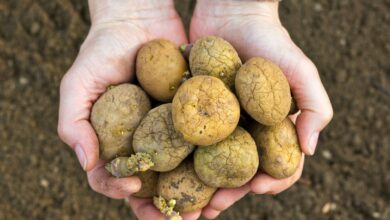Deformed potatoes with knots: why are potato tubers deformed?

If you’ve ever grown potatoes in your garden, chances are you’ve harvested some interesting potatoes. When potato tubers are deformed, the question is why and whether there is a way to avoid potatoes that are deformed by knots. Read on to find out more.
Causes of knotted potatoes
In order to know how to avoid oddly shaped potatoes, it is necessary to understand the causes of gnarled and deformed potatoes. In fact, it’s very simple. Any stress on the developing tuber causes the tuber to become deformed. What kind of stress? Temperature flow and poor planting are two important factors.
In the case of temperature, high temperatures cause stress in the field. In general, the longer the tuber variety, the more sensitive it is. If you live in an area where temperatures are regularly high, be prepared. Avoid planting the longest tuber varieties and irrigate sufficiently during the initial growth phase. Also, don’t aggravate stress by adding too much nitrogen.
To allow good potato development and prevent tuber deformation, it is important to have smooth, clod-free soil with space between each plant. Long runners (2-4 cm), with roots attached to the tuber, should be encouraged. These runners absorb all the nutrients and water needed for growth. When the runners are tight, twisted, diseased or under stress, the plant cannot absorb the nutrients needed to produce smooth, flawless potatoes. Short runners limit the growth of tubers and cause them to compete for space, resulting in potato protuberances and other malformations.
Short runners also promote diseases such as rhizoctonia, which will cause the plant to lose its first set of tubers and subsequent sets will be severely deformed.
However, an abnormally long runner can also cause malformations in potatoes. Runners that are too short or abnormally long cause hormonal imbalance and affect the general shape of the potato.
Bumps on potatoes are also due to growth stimulation in one or more of your eyes. The size of the bumps depends on the growth stage of the tuber when a stressor occurs. High temperatures are the cause of this stimulated growth.
How to repair potato deformations
As mentioned above, plant the tubers in aerated, lump-free soil. If you live in a place where it is usually warm, plant the right variety of potatoes: small, short potatoes. Temperatures above 80 F. (26 C.) reduce the carbohydrate supply to the tuber and decrease cell division, resulting in poorly formed potatoes.
Water regularly during the first phase of growth and avoid excess nitrogen. Leave plenty of space between plants so that they can develop long runners with a large diameter to better absorb nutrients.




